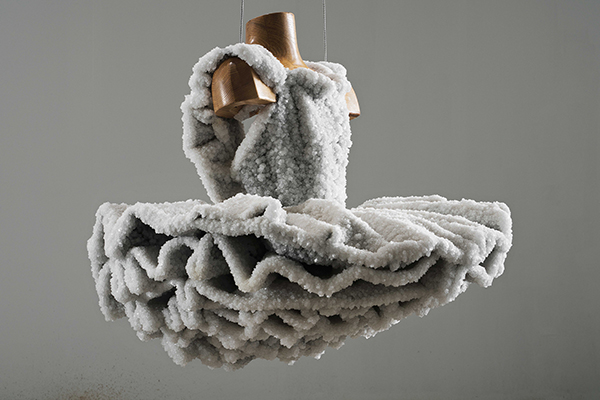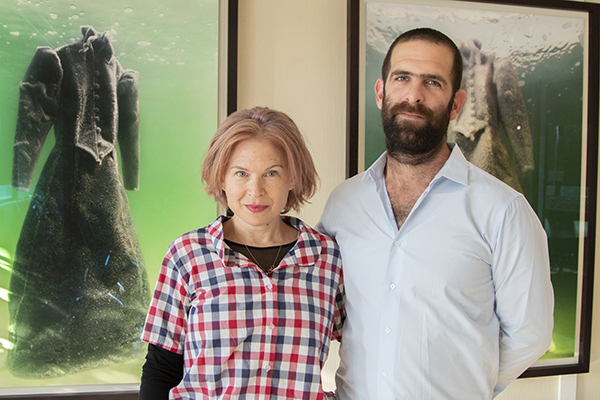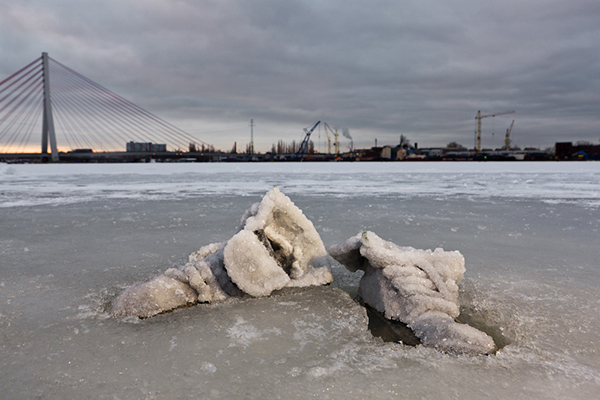08/07/2019
5 Questions with...Debbie Yasinow
- Share This Story

“Tutu” (2017) by Sigalit Landau and Yotam From. Color print. 137 x 92 x 4 cm. Edition: 5/9 + 2AP. Image courtesy of the Cleveland Israel Arts Connection.
Article reprinted with permission from Canvas Magazine
The director of the Cleveland Israel Arts Connection, a program of the Jewish Federation of Cleveland, talks about Israeli artist Sigalit Landau’s “Growth & Change,” which is on view through Oct. 27 at the Roe Green Gallery inside the Jewish Federation of Cleveland’s Jack, Joseph and Morton Mandel Building.
What can visitors look forward from Sigalit Landau’s “Growth & Change”?
Curator A. Will Brown, formerly of the Museum of Contemporary Art Cleveland, visited Sigalit Landau and Yotam From at their studios in Tel Aviv and near the Dead Sea to select works for “Growth & Change.” In his words:
“Israeli artists Sigalit Landau and Yotam From work as a team to create poignant and often incisive artworks across many forms. This exhibition presents a group of works that explore powerful metaphors about the nature of being human.
“Landau has long engaged with the Dead Sea as a site of meaning and a place to generate new artworks. Over months of soaking in the depths of the Dead Sea, Landau and From have brought to life projects that include the Salt Crystal Bridal Gown (2014) series of sculptures and photographs and numerous salt-encrusted objects. In addition, Landau has made both map-like and relationally focused etchings while exploring the Dead Sea, such as the Salt Wedding (2016) portfolio and the Bridge Map (2014), which is one in a larger series.”

Sigalit Landau and Yotam From stand in front of “Salt-Crystal Bridal Gown III” (2014) and “Salt-Crystal Bridal Gown VIII” (2014) at the Jewish Federation of Cleveland’s Jack, Joseph and Morton Mandel Building in Beachwood. Image courtesy of the Cleveland Israel Arts Connection.
What inspires Landau to select the objects she does for her works? Do those objects represent recurring artistic themes, and if so, can you elaborate?
Sigalit’s passion with the Dead Sea stemmed from her childhood in Jerusalem, where she was able to gaze outside her window and view the reflections off the water. After her mother’s death, she was drawn back to the sea as a connection to her memories. Many of the objects she selects also deal with memory, such as the shoes and an empty stretcher. The tutu is nostalgic from her youth when she was an accomplished dancer – also now just a memory. The Salt Bride images were conceived in part by the memory of bridal boutiques in a neighborhood where she lived when her daughter was very young. The series was further inspired by a costume exhibit at Habima, Israel’s national theater, featuring the dress worn by Hanna Robina in “The Dybbuk.”
Salt in Israel plays a much different role than salt in Northeast Ohio and other locations with seasonably cold winters. In what ways does Landau explore this contrast in her art?
Salt is a preservative. Biblically, we dip challah in salt because salt never spoils, just as G-d’s covenant with the Jewish people is eternal. In Cleveland, however, salt is used to destroy – as evidenced by the perennial appearance of potholes in our city streets. Not many Israelis know that salt melts ice, but Sigalit knew from her experiences in Berlin and Philadelphia that salt is a winter necessity.
To explore the destructive nature of salt, Sigalit and Yotam developed the “Gdansk Series” where they took salt-encrusted boots to a frozen river in Gdansk, Poland. Gdansk was chosen for several reasons in addition to its climate. The former name of Gdansk was Danzig, and Sigalit is an admirer of the Israeli sculptor Itzik Danziger. Danzig also means “dancer,” which Sigalit used to be. And in recent history, Gdansk shifted countries between Poland and Germany, where Sigalit’s family came from before the war.
In the “Gdansk Series” the salt boots are placed on the frozen river. Still photos taken throughout the day show the boots as they slowly melt through the surface, ultimately to sink into the river’s depths. What remains are two holes in the ice, a memory of what had once been there.

“Gdansk #5 (2011) by Sigalit Landau and Yotam From. Color print. 80 x 114 x 5 cm. Edition: 2/6 + 2AP. Image courtesy of the Cleveland Israel Arts Connection.
This show was brought to Northeast Ohio by the Cleveland Israel Arts Connection. For those who aren’t familiar, will you describe the organization’s role in the local arts community and what it brings to the region?
The Cleveland Israel Arts Connection is a program of the Jewish Federation of Cleveland, connecting our community with the most dynamic 21st century cultural experiences that Israel has to offer. Working in partnership with Northeast Ohio’s leading arts organizations, we strive to identify, enhance, promote and create unique and engaging Israeli cultural opportunities.
In order to accomplish these goals, we meet regularly with creative leaders throughout Cleveland’s cultural community to introduce them to opportunities for collaboration. We often are able to facilitate “exposures” where the artistic directors travel to Israel for several days to experience the artform firsthand. They attend performances, visit galleries and studios, and meet with artists, actors, choreographers, playwrights and directors. We’ve been fortunate to send people to exposures for visual art, world music, jazz, dance and theater.
In the past 10 years, we have helped identify and bring in more than 100 Israeli musicians, composers, visual artists, authors, dance companies, choreographers, actors, theater troupes and filmmakers to our community in partnership with more than 50 of Cleveland’s fine-art institutions. Our upcoming season includes many Israeli films at both the Mandel JCC’s Jewish FilmFest and the Chagrin Documentary Film Festival, exciting new visual art exhibitions at the Roe Green Gallery, conversations with author Dorit Rabinyan, and musical partnerships with the BlueWater Chamber Orchestra, the Cleveland International Piano Competition and The Cleveland Orchestra, which will present the world premiere of a concerto by composer Oded Zehavi.
You can visit jewishcleveland.org/involved/arts to learn about upcoming opportunities to experience Israeli art in Cleveland.
How can those interested in seeing “Growth & Change” go about doing so?
Open Houses on the following dates are free and open to the public and include docent-led tours:
1 to 3 p.m. Sunday, Aug. 18
6 to 8 p.m. Tuesday, Aug. 20
1 to 3 p.m. Sunday, Sept. 15
6 to 8 p.m. Tuesday, Sept. 17
1 to 3 p.m. Sunday, Oct. 27
Outside of Open House hours, you can visit the Roe Green Gallery by appointment or schedule group tours. Please email israelarts@jcfcleve.org or call 216-593-2845.

